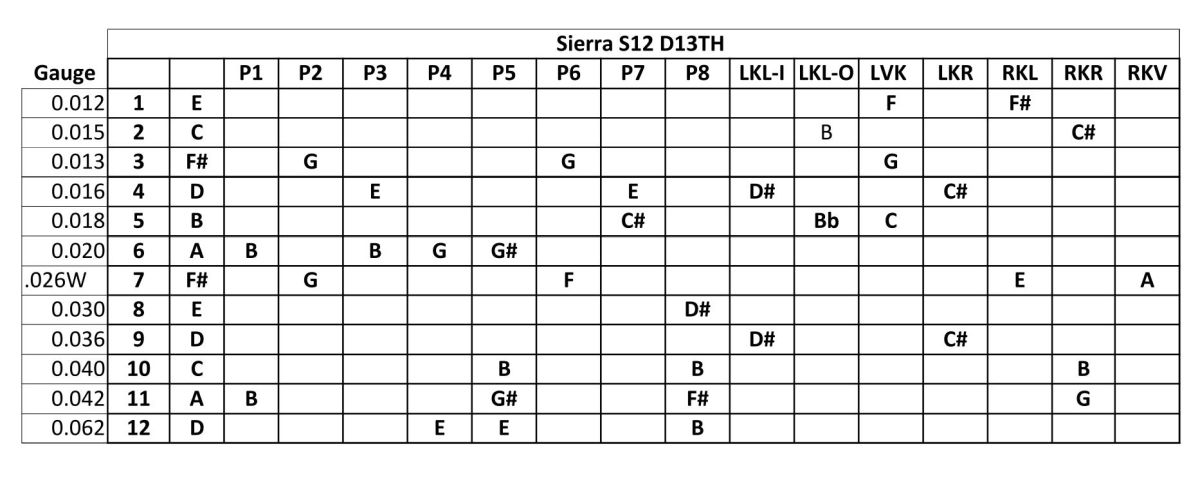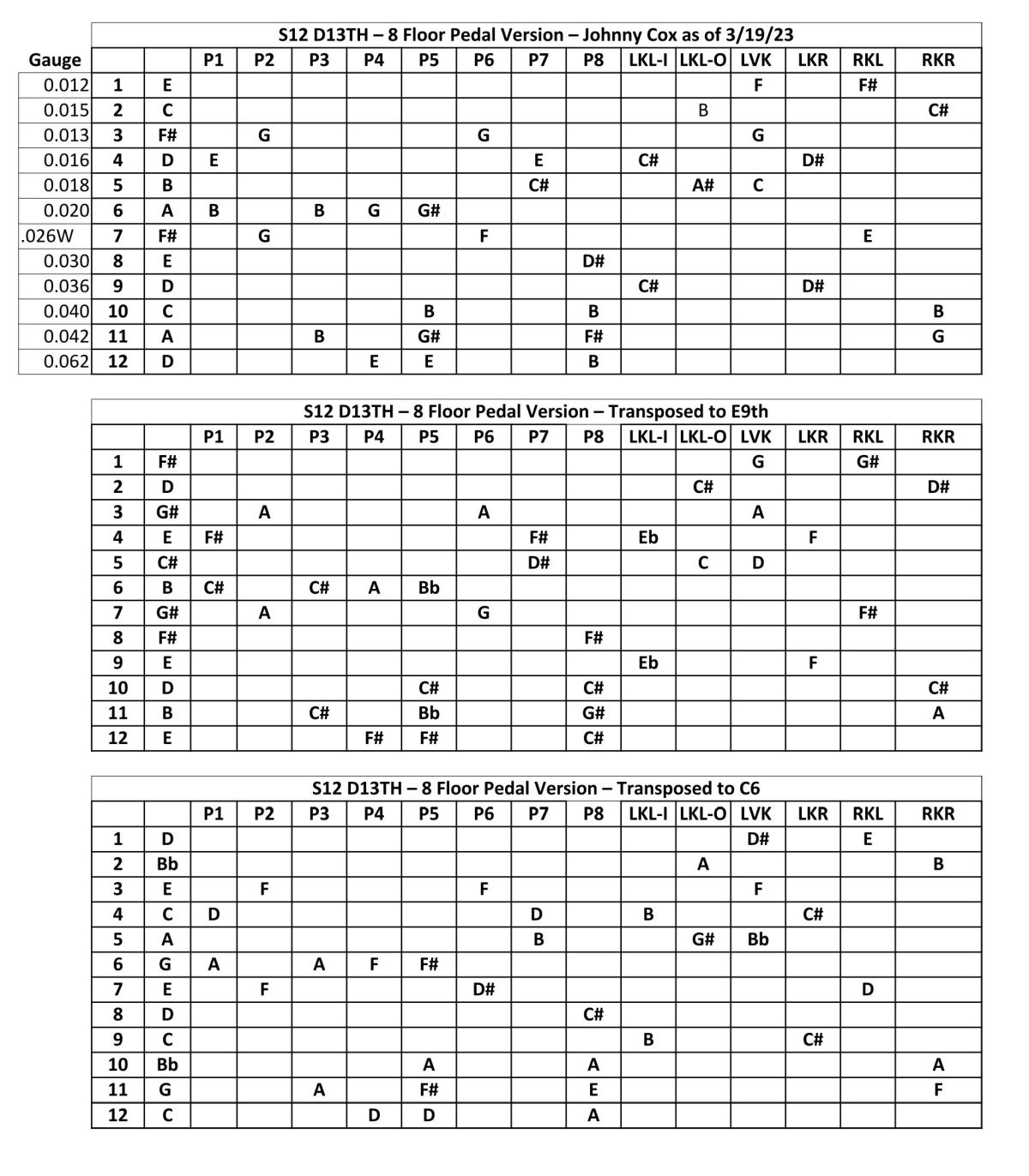D13 Pedal steel copedant, tabs and sounds
This page is dedicated to the 12 string D13th pedal steel copedant that was developed by Johnny Cox. Check out Johnny's Facebook Page for some excellent discussion and video tutorials related
to this tuning. I have adapted this tuning to my own needs and what is currently installed on my guitar is shown immediately below. I will post eventually and hopefully, about 50 tabs and a bunch
of audio files that I have created with this tuning. Some of these have been gleaned from Johnny Cox's playing and some are uniquely my own. This D13th tuning is installed on my Excel 12 string
keyless guitar and will also be installed on a new Sierra pedal steel I have on order. Note that I have changed my LKL, LKR, P1 and P3 to the Emmons setup versus the Day setup that Johnny uses.
Having played this setup for a few months I must admit that the Day setup makes more sense in terms of proximity of pedals. A few things I have learned so far:
|
|
Copedant on my Excel and Sierra guitars
- Copedant in PDF format
- Hear what my new RKV sounds like!
- Hear RKV and LKV together
- Using the "extra" 5th string on an E9th mode riff.
- Zane Beck style riff
- Copedant in PDF format
- Sweet Dreams
- Split Franklin Pedal
- Sound Sample 8
- Sound Sample 7
- Sound Sample 6
- Sound sample 6
- Sound Sample 5
- Sound Sample 4
- Sound Sample 3
- Sound sample 2
- Sound Sample 1
- RKL, LKV, Pedals 4,5,6 and 8 Chalker Sounds
- Pedal 4.mp3
- Pedal 4 + LKL outer lower string 5
- No Pedals
- No One Will Ever Know D13
- No One Will Ever Know D13 Track
- More Low String Sounds 2
- More Bassman Sounds
- Mixed E9th C6 Sounds
- LKV Chalker
- Green Light Snippet
- Detroit City
- D13 pedals 1,2,5,6,and 7 Axe FX3
- D13 Axe Fx3 Stereo Reverb
- D13 Axe Fx3 Effects
- D13 Axe FX3 Bottom Strings
- A Fool Such As I
- 33.Shimme
- 26.John
- 23.Glass
- 20.Twin Plate Reverb
- 18.Night Plate Reverb
- 7.Pure57 Reverb Changed To Plate 4.0 Seconds
- 2nd String Tuned To C Sharp
- 2.Twin Factory With Room Reverb Cranked Up
- 1.MKV
- 0.SPRVRB Factory Room Reverb
- TT15 Direct 1
- TT15 Direct 2p
- TT15 Direct 3
- TT15 Direct 4
- TT15 FRF 1
- TT15 FRF 2
- TT15 FRF 3
- TT15 FRF 4
- TT15 FRF 5

Here's my new RKV combined with the LKV knee lever. Notice the the last section changes the string selection a bit. Another reason that the 5th string is not always in the way in E9th mode!
The riff below can be played many different ways and easily on a standard E9th tuning. In this case using the "extra" 5th string in E9th mode
just makes the finger grips faster and more uniform. Of course with the D13 tuning you don't have to finish with standard E9th stuff so why not
Boo Wah it!
If you're a big Zane Beck fan this tuning can emulate a lot of his awesome licks. Here's one below that combine the "E9th" pedals
with the "C6" pedals and includes a few of his trademark riffs and thumb sweeps.
|

|
D13 Pedal Steel Tabs (uses my Emmons pedal setup for P1,P3, LKR, LK-I)
|
D13 LKV Example 1 |
Tab |
Audio |
|
D13 Tab Pedal 4 LKL-O |
Tab |
Audio |
|
D13 Tab Pedals 4,5,6,7 |
Tab |
Audio |
|
D13 Tab No Pedals |
Tab |
Audio |
|
D13 Tab LKV Chalker |
Tab |
Audio |
|
D13 Tab P6,RKR,LKV Example 2 |
Tab |
Audio |
|
D13 Tab P6,RKR,LKV Example 3 |
Tab |
Audio |
|
D13 Tab Pedal 4 |
Tab |
Audio |
|
D13 Tab RKR Lower Strings Riff |
Tab |
Audio |
|
D13 Tab Maj7 Min7 13b9 Chords (Direct copy of E9th grips and ala E9th D to C# knee lever) |
Tab |
Audio |
|
D13 Tab Pedal 4 and More |
Tab |
Audio |
|
D13 Tab Detroit City |
Tab |
Audio |
|
D13 Tab RKL and RKR |
Tab |
Audio |
|
D13 Tab Single String Plus RKR |
Tab |
Audio |
|
D13 Tab 13b9 and Major 9th Chords |
Tab |
Audio |
|
D13 Tab Stock E9th Lick |
Tab |
Audio |
|
D13 Tab Low String Vamp |
Tab |
Audio |
|
Stock C6 Lick |
Tab |
Audio |
|
D13 Tab Pedal 7 Workout |
Tab |
Audio |
|
D13 Tab Pedal 8 Walkup |
Tab |
Audio |
|
D13 Tab String 6 Yoyo |
Tab |
Audio |
|
D13 Tab Pedal 8 Drop String 10 Plus 2 More Tabs |
Tab |
Audio |
|
D13 Sound Samples. These are not tabbed out and may overlap a few of the tabbed examples provided above.
Comments? email webmaster Greg ![]()
![]()